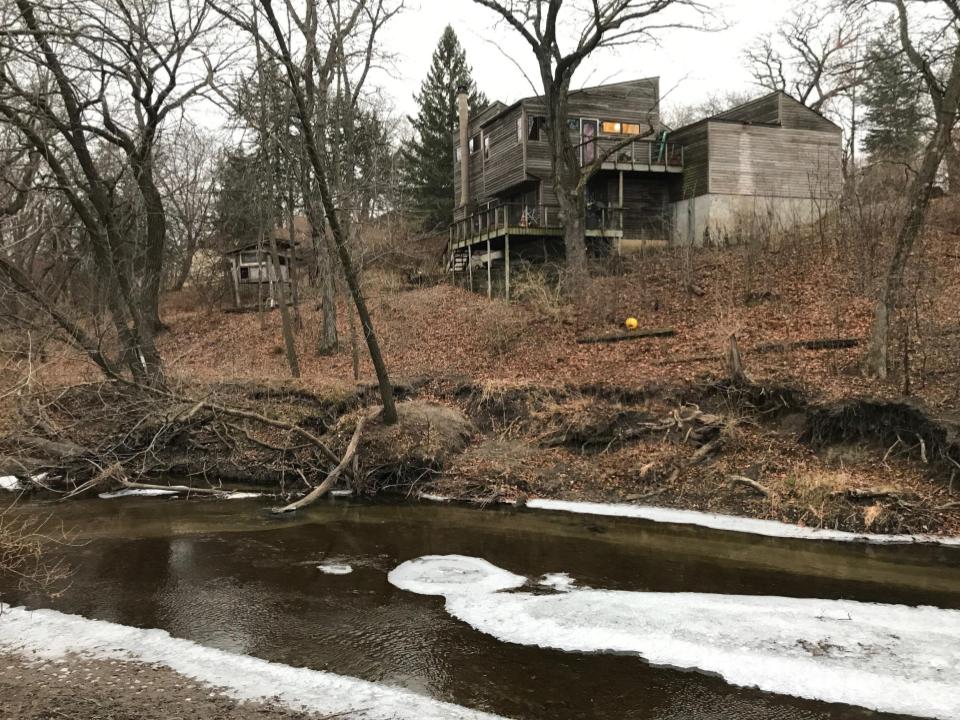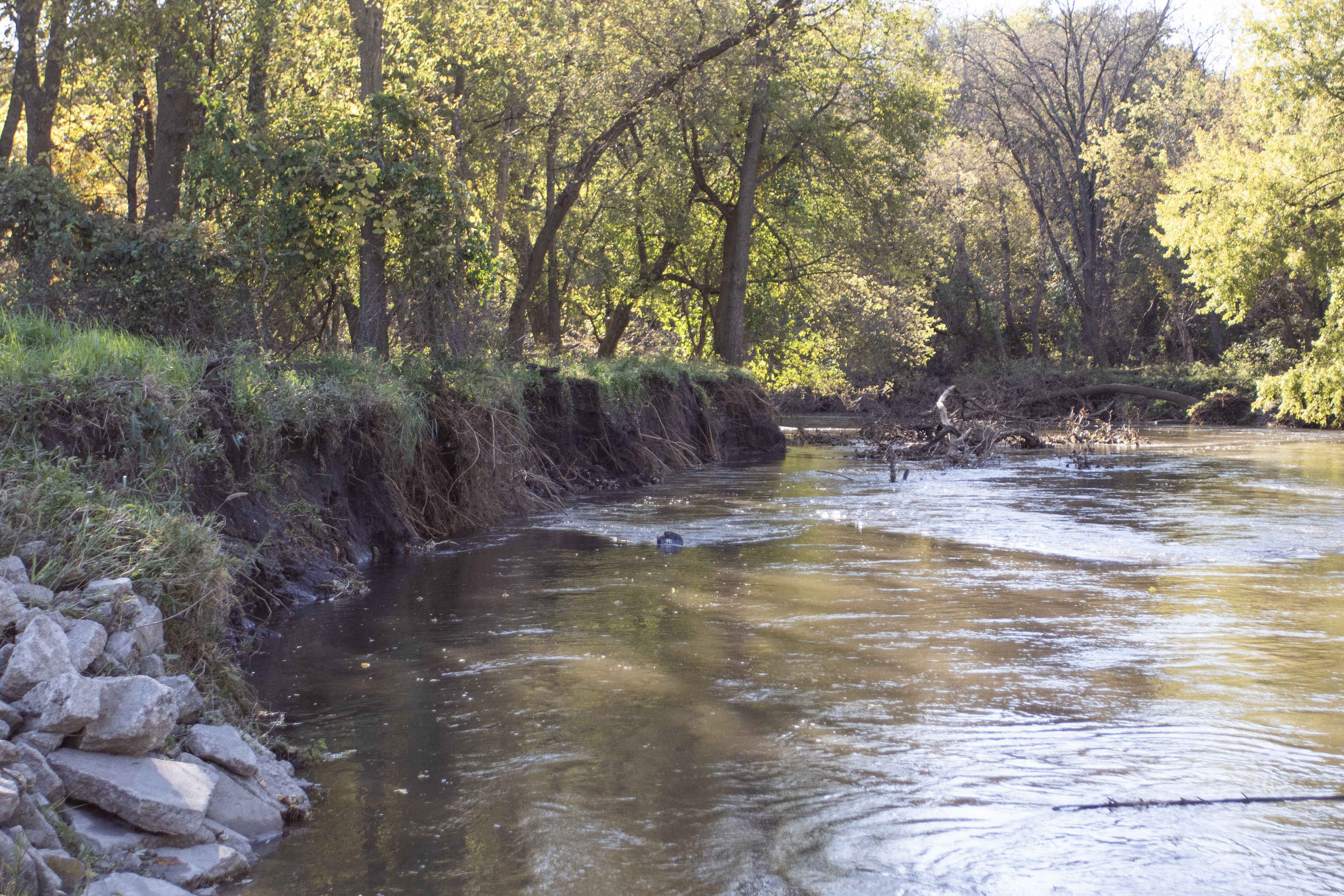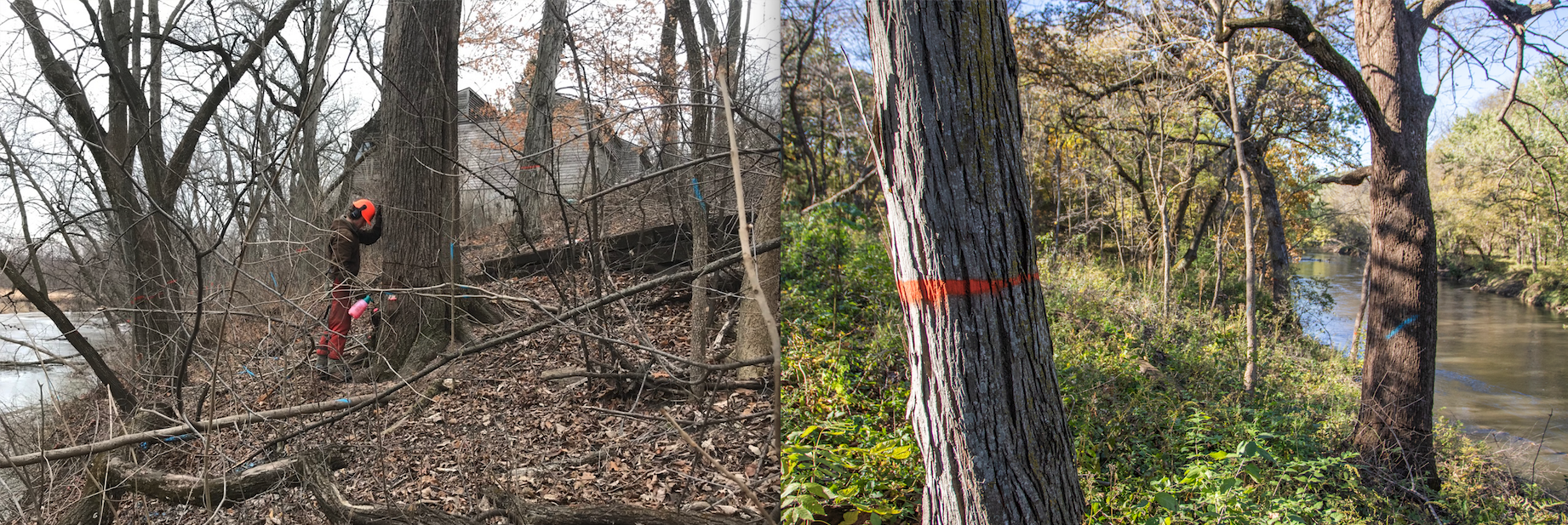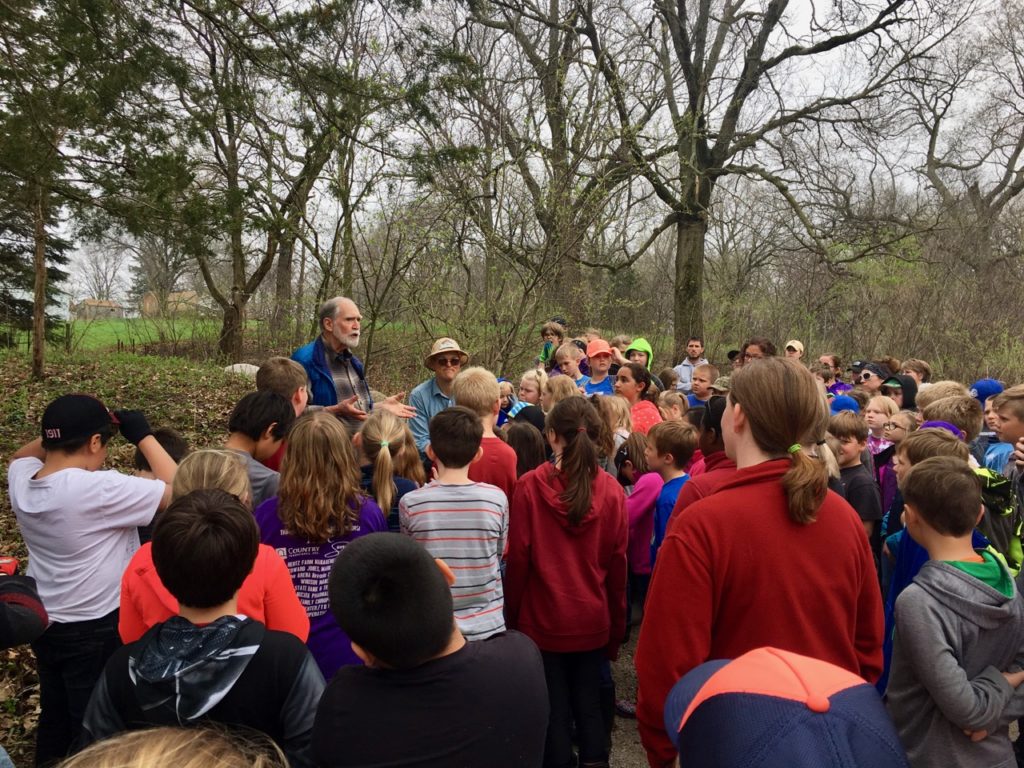Neighborhood Collaboration Protects Land, Evaluates Streambank Erosion

Dick Van Deusen is harnessing living ecosystems to protect his hillside home from streambank erosion. Pictured here with spouse, Marjorie Sigel.
In 1971, Dick Van Deusen’s quiet woodland home near Ames was still under construction when he learned that the field across the creek was for sale. A prospective buyer intended to develop a motorcycle racetrack. Horrified at the prospect of the quiet Squaw Creek overlook being filled with smoke and engine noise, Dick set to work to find another buyer. Two of Dick’s neighbors were interested, and the three of them, “…scratched together our nickels and dimes and purchased it,” recalled Dick.
For four decades, the 35 acres of bottomland farm fields faced regular deluges from the adjacent creek. The revenue, “…barely covered the cost of taxes, insurance, fertilizer, and cost of labor to get the crop in,” noted Dick. When the tenant farmer suggested enrollment in the Conservation Reserve Program (CRP) in 2012, “We realized that an annual fixed amount of rent we could rely upon [for growing prairie] was a far better position.”

Dick knew it was time to take action when the streambank beneath his home began to slough off into Squaw Creek.
A few years into the contract, Dick contacted Prudenterra to conduct a prescribed burn for mid-contract management. When Luke arrived to prepare the burn site, he noticed something disturbing about Squaw Creek. Streambank erosion was eating away at the edge of the CRP and downstream, and it was rapidly stealing chunks of the hillside on which Dick’s home rested. Luke invited his colleague, ecologist Lee Searles, to examine the site alongside him.
Dick also reached out to experts from a handful of local not-for-profit and government agencies to help advise a course of action. The experts confirmed that managing the speed, direction, and volume of water ultimately starts upstream. However, “Whatever we can do to increase the resistance of the bank as it goes through my lot will be a big help,” explained Dick.
While Dick was charting longer-term improvements, some of his advisors recommended that he take immediate action to halt gully erosion at the edge of the CRP prairie. “Everyone agreed that if it were not addressed in not too many more flood seasons, it would start to take a more direct path–right across the field.” In 2016, Dick hired earthmovers to reshape the field gully at the stream meander, lay landscape fabric, deposit riprap (in this case, concrete rubble), and reseed prairie on the disturbed soil.

A triangle of riprap rests on a resurfaced gully. The gully formed at the point where water flowed out of the CRP prairie and into Squaw Creek via the weakened streambank. Today, many stream restoration experts recommend using living vegetation to hold reshaped banks in place and often utilize rocks only to stabilize a small area along the base of the slope.
Unfortunately, this action did not put an end to the erosion. As ecologist Lee Searles reflected, “The riprap is already failing because it didn’t address the root problem upstream. The bank is eroding because of significant downcutting–the elevation of the streambed has gone down. This is due to the fast flow and large volume of water from tile drainage and loss of wetlands and perennials.”
“Re-grading and riprap were kind of a band-aid and not a long-term solution,” acknowledged Dick. “The real solution is to slow down the water coming from upstream. It will take talking with a lot of private landowners [and convincing them] that this is a problem that needs to be addressed. They will need to take their share of the responsibility for what is going on.”
In spite of these hydrological forces, Searles and other stream restoration experts say the banks can be stabilized in a way that not only prevents their erosion, but reduces flooding elsewhere by storing more water in the channel and slowing the speed of flow. For example, the bank can be moved back to create a low toe floodplain. Then, the shape of the bank can be reduced from a vertical 90° angle to a 60° angle and planted with willows and other well-rooted native perennials to hold it in place.

Some of the causes of stream erosion are agricultural–drainage tiles move rainwater swiftly from crop fields into streams, causing a rapid rise in water levels. Another factor–straightened streams, which speed the flow of water and disconnect streams from their floodplains. Impervious surfaces such as pavement and climate change-induced heavy rains have further exacerbated these issues.
“Now that we’re looking at it, interesting questions are arising,” mentioned Dick. “For example, should the CRP land be converted to wetland. That would do a lot to help downstream conditions…it would retain much more water during floods.”
These stabilization techniques will benefit both the CRP prairie, and the the hill the house rests on downstream. Unfortunately, the stretch of stream leading up to the house is straight because of a natural bluff with a thick blue clay layer that prevents the stream from meandering. Without curves in the streambed to slow the water, it gathers speed before encountering the hillside beneath Dick’s house. Further exacerbating the instability: an old, humanmade boulder jetty that directs the flow of water toward the vulnerable hillside, and an improperly designed home tile drainage outlet that has been unleashing chunks of land into the creek.
Lee Searles says that the most effective way to stabilize the creek is to re-meander it: dig out a new meander away from Dick’s home, and backfill the old streambed. A less costly option is a feature called a vane–a line of wooden posts or rocks that pushes the fastest moving part of the stream away from the bank and into the center of the streambed. This can create a toe floodplain and aid in protecting the bank above where the soil is more vulnerable to erosion.

On the left: In January of 2018, a Prudenterra crew member cuts and sprays invasive buckthorn, honeysuckle, Russian olive, and burning bush shrubs. Oak and hickory trees were marked in orange to remain intact. Other species of trees were marked in blue and cut or girdled and sprayed to enable more sunlight to reach the ground layer of vegetation. To the right: In October of 2018, dense vegetation stabilizes the hillside.
Beyond addressing an eroded bank, managing the oak-hickory woodland above it can help hold soil in place by promoting a densely rooted ground layer of native vegetation. In January of 2018, Dick took the first step of stabilizing the hillside–he hired Prudenterra to remove invasive shrubs and all trees except oak and hickory to allow more sunlight to reach the forest floor. The increased ground layer growth will enable prescribed woodland burns to be ignited to support a healthy, native community of fire-adapted savanna species.
Meanwhile, Dick continued to reach out to experts and assess his options while determining how to proceed. “My real interest is to get all of these parties to seriously get together and pool our various resources. There are county, federal, and university research funds. There is a way to do something wonderful up and down the creek–not just in my particular chunk. If we got smart and put the whole thing together as a unified project…I think it is possible.”

Dick spoke about land stewardship to the students and other participants in the service learning project. Practices that Dick may employ to manage his land with living systems include tree and shrub plantings, wetland reconstruction, and forest management.
In the spring of 2018, that was the message that Dick shared with 250 children from the multi-age program at Central Elementary School, along with teachers, parent chaperones and volunteers who conducted a service-learning project on his land. With grant funding from Trees Forever, ITC Midwest, Nevada Kiwanis, and the Nevada Community School District Enterprise Fund, students from Nevada, Iowa planted native shrubs, trees, and wildflowers to further stabilize the slope below Dick’s house. They also placed painted stones beneath drainage tile outlets to disperse the energy in the water, and track the movement of the stones downstream in future floods.
Dick is thrilled that the challenge he is facing has brought important stewardship issues to the attention of the next generation. “There were various conversations throughout the day. Folks got it–that we need to do better in being good keepers or managers of this land.”
In coming months, Dick will be focused on harnessing living systems for long-term erosion mitigation. It may not be as straightforward as preventing a motorcycle racetrack from moving in next door, but by joining forces with neighbors and restoration experts, stream stabilization is within reach. “What we’re dealing with is a process and not an event. You can’t say ‘we dumped some riprap and now we’re done’. We’re altering the process so there can be better outcomes.”

